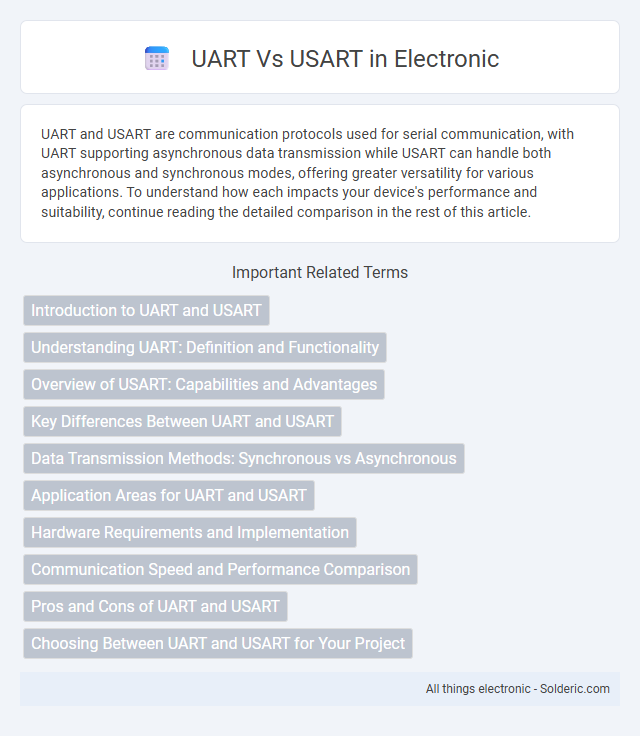UART and USART are communication protocols used for serial communication, with UART supporting asynchronous data transmission while USART can handle both asynchronous and synchronous modes, offering greater versatility for various applications. To understand how each impacts your device's performance and suitability, continue reading the detailed comparison in the rest of this article.
Comparison Table
| Feature | UART | USART |
|---|---|---|
| Definition | Universal Asynchronous Receiver Transmitter | Universal Synchronous/Asynchronous Receiver Transmitter |
| Communication Mode | Asynchronous only | Asynchronous and Synchronous |
| Clock | No external clock needed | Requires external clock in synchronous mode |
| Data Transmission | Uses start and stop bits | Uses start, stop bits (async) and clock signals (sync) |
| Speed | Lower speed due to asynchronous nature | Higher speed supported in synchronous mode |
| Complexity | Less complex | More complex with additional features |
| Use Cases | Simple serial communication | Versatile in serial communication: sync & async |
Introduction to UART and USART
UART (Universal Asynchronous Receiver/Transmitter) and USART (Universal Synchronous/Asynchronous Receiver/Transmitter) are hardware communication protocols used for serial data transmission. UART transmits data asynchronously without a clock signal, while USART supports both asynchronous and synchronous communication, allowing data exchange with or without a clock. Understanding the difference between UART and USART helps optimize your embedded system design for specific timing and data integrity requirements.
Understanding UART: Definition and Functionality
UART (Universal Asynchronous Receiver/Transmitter) is a hardware communication protocol that enables asynchronous serial communication between devices by converting parallel data into serial form and vice versa. It operates without a clock signal, relying on start and stop bits for data synchronization, making it ideal for simple, low-speed data exchanges. Understanding UART functionality helps you design efficient communication systems where timing coordination and hardware simplicity are crucial.
Overview of USART: Capabilities and Advantages
USART (Universal Synchronous/Asynchronous Receiver/Transmitter) offers flexible communication by supporting both synchronous and asynchronous data transmission modes, making it ideal for various applications requiring precise timing and high-speed data transfer. Its capabilities include clock synchronization for error-free data exchange and compatibility with SPI or I2C protocols when used synchronously, enhancing your device's connectivity. The advantage of USART lies in its versatility and efficiency, allowing seamless integration into complex embedded systems where reliable serial communication is critical.
Key Differences Between UART and USART
UART (Universal Asynchronous Receiver/Transmitter) and USART (Universal Synchronous/Asynchronous Receiver/Transmitter) primarily differ in their communication modes; UART supports only asynchronous communication, while USART can handle both synchronous and asynchronous data transmission. USART offers greater versatility with the ability to synchronize data clocks for faster and more reliable transfers, whereas UART relies solely on start and stop bits for timing. Understanding these key differences helps you select the appropriate interface for your microcontroller-based communication needs.
Data Transmission Methods: Synchronous vs Asynchronous
UART (Universal Asynchronous Receiver/Transmitter) uses asynchronous data transmission, where data bits are sent without a shared clock signal, relying on start and stop bits for synchronization. USART (Universal Synchronous/Asynchronous Receiver/Transmitter) supports both asynchronous and synchronous transmission methods, enabling data transfer with or without a clock signal. Synchronous mode in USART allows higher data rates and improved timing accuracy by transmitting data bits in sync with a clock pulse, while UART's asynchronous mode offers simpler wiring and broader compatibility.
Application Areas for UART and USART
UART is widely used in simple serial communication applications such as microcontroller to PC data transfer, GPS modules, and Bluetooth devices due to its straightforward asynchronous protocol. USART, supporting both asynchronous and synchronous communication modes, finds applications in more complex systems including high-speed data transfer in embedded systems, industrial automation, and communication between microcontrollers and external peripherals like modems. The flexibility of USART makes it suitable for versatile industrial and communication equipment requiring synchronized clock signals and robust data integrity.
Hardware Requirements and Implementation
UART (Universal Asynchronous Receiver/Transmitter) requires minimal hardware, typically just a microcontroller with built-in UART support, relying on asynchronous communication without a clock line. USART (Universal Synchronous/Asynchronous Receiver/Transmitter) demands additional hardware components such as a clock generator for synchronous mode, enabling both synchronous and asynchronous data transmission. Implementing USART involves more complex timing control and synchronization circuitry compared to UART, increasing overall hardware complexity and resource usage.
Communication Speed and Performance Comparison
UART (Universal Asynchronous Receiver/Transmitter) supports communication speeds typically up to 1 Mbps, while USART (Universal Synchronous/Asynchronous Receiver/Transmitter) can achieve higher speeds, often exceeding 10 Mbps in synchronous mode due to its clock synchronization capability. USART provides improved performance in terms of error handling and data integrity by utilizing synchronous communication, reducing latency and increasing throughput compared to asynchronous UART. The choice between UART and USART heavily depends on the application's required data rate and timing precision, with USART offering superior speed and efficiency in time-critical systems.
Pros and Cons of UART and USART
UART offers simplicity and ease of implementation, making it ideal for basic serial communication with fewer configuration options and lower cost. USART provides flexibility by supporting both asynchronous and synchronous modes, enhancing data transmission speed and reliability at the expense of increased complexity and resource usage. Your choice depends on the specific application requirements for speed, synchronization, and hardware capabilities.
Choosing Between UART and USART for Your Project
Selecting between UART and USART depends on your project's communication needs and hardware capabilities. UART offers simple asynchronous serial communication ideal for low-speed data transfer, while USART supports both asynchronous and synchronous modes, providing greater flexibility and higher data rates. Consider USART if your project requires clocked synchronization or more complex data framing; otherwise, UART is sufficient for straightforward serial communication tasks.
UART vs USART Infographic

 solderic.com
solderic.com